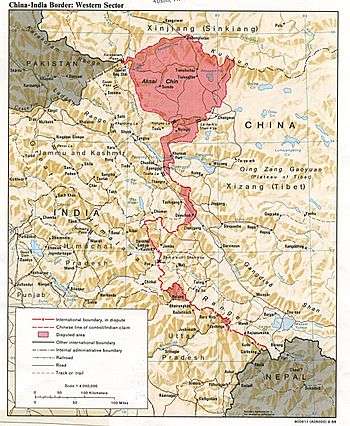Daulat Beg Oldi
| Daulat Beg Oldi (DBO) | |
|---|---|
| military base | |
 Daulat Beg Oldi (DBO)  Daulat Beg Oldi (DBO) Location in Jammu and Kashmir, India | |
| Coordinates: 35°23′24″N 77°55′30″E / 35.390°N 77.925°ECoordinates: 35°23′24″N 77°55′30″E / 35.390°N 77.925°E | |
| Country |
|
| State | Jammu and Kashmir |
| District | Leh |
| Elevation | 5,100 m (16,700 ft) |
| Languages | |
| • Official | Urdu |
| Time zone | IST (UTC+5:30) |

Daulat Beg Oldi (also Oldie, DBO), Ladakh, state of Jammu and Kashmir, India is a historic camp site and current military base located on an ancient trade route connecting Ladakh to Uyghuristan. The Chip Chap River flows just to the south of Daulat Beg Oldi from east to west. Daulat Beg Oldie also has an airstrip at an altitude of 5065 meters (16,614 feet), which is the world's highest airstrip.
Location and physical conditions
Daulat Beg Oldi lies near the easternmost point of the Karakoram Range in a cold desert region in the far north of India, just 8 km south of the Chinese border and 9 km northwest of the Aksai Chin Line of Actual Control between China and India. Other than Siachen Glacier military bases, it is India's northernmost built-up area. The nearest inhabited town is Murgo (literally: "the gateway of death" in Yarkandi Uyghur) to the south, which has a small population of Baltis who primarily depend on apricot farming and yak rearing.
The Indian government first announced plans in 2001 to construct a motorable road from Leh to its destination at Daulat Beg Oldi.
Temperature plummets as low as -30 C in the winters. The weather deteriorates frequently with strong icy winds lashing much of DBO. DBO has very little if any vegetation or wildlife. Communication is possible only through INMARSAT (satellite) phones.
History
The place is named after Daulat Baig, a 16th-century Yarkandi nobleman who is supposed to have died at this place after descent from the Karakoram Pass, which is 17 kilometers to the northwest on the Indo-Chinese border. Daulat Baig Oldi literally means, "Daulat Baig Died".This route was used by caravans of traders traveling between India and Central Asia. It used to be a stopping point for the caravans traveling along the Silk Road. India and China sealed their borders after the 1962 India-China War, ending most of the cross-border trade. In modern times, the place has not been known to have any permanent civilian population.[1]

In April 2013, a platoon-sized contingent of the People's Liberation Army established a campsite 30 km southeast of DBO,[2] a location in the Indian military's "DBO sector." In reference to their own perception of the LAC's location, India initially claimed that the Chinese camp was 10 km on their side, later revising this to a 19 km claim,[3] and claimed that Chinese military helicopters had violated Indian airspace during the incident.[4] In early May, both sides withdrew their units further back.
Advanced Landing Ground
| Daulat Beg Oldi Advanced Landing Ground | |
|---|---|
 | |
| IATA: none – ICAO: none | |
| Summary | |
| Airport type | Military |
| Operator | Indian Airforce |
| Location | Ladakh, India |
The Indian Army maintains helipads and a gravel air strip here, the highest airstrip in the world. Routine sorties are carried out using An-32 aircraft to provide relief and supplies to the troops stationed nearby.[5] The base was established during the Sino-Indian conflict in 1962, with the first landing by Squadron Leader C.K.S Raje who set a record for the world's highest aircraft landing at the time. It was operated with American-supplied Fairchild Packets from 1962 to 1966, when it had to be closed down suddenly when an earthquake caused loosening of the surface soil, making the area unsuitable for fixed-wing aircraft.[6] Work was undertaken to make the airfield operational again, and was marked on 31 May 2008, when an Indian Air Force An-32 landed.[7]
The Indian Air Force first landed transports here between 1962 and 1965 and then after a gap for 43 years, the IAF started landing at DBO four years ago. In a significant demonstration of its capabilities, the Indian Air Force landed a C-130J Super Hercules transport aircraft in Daulat Beg Oldie on 20 August 2013, thirty kilometers from where the 2013 Daulat Beg Oldi Incident took place in April 2013. This landing could qualify as a world record for a medium-lift aircraft landing at this altitude.[8][9][10]
See also
References
- ↑ "The Himalayas - Ladakh Himalayas - Villages and Plateus - Shyok Valley". Retrieved 31 May 2008.
- ↑ "India is no Pushover". Retrieved 7 May 2013.
- ↑ "China's Ladakh Incursion Well-planned". The Times Of India. Retrieved 7 May 2013.
- ↑ "China's Helicopters Violate Indian Airspace". Retrieved 7 May 2013.
- ↑ "IAF Aircraft lands at the highest airstrip in the world". The Times of India. 31 May 2008. Retrieved 31 May 2008.
- ↑ "IAF reopens old airbase in Ladakh region". The Times of India. 31 May 2008. Retrieved 31 May 2008.
- ↑ "IAF reopens old air base near China border". The Times of India. 31 May 2008. Retrieved 31 May 2008.
- ↑ "IAF's C-130J transporter lands near India-China border". Business Standard. 20 August 2013. Retrieved 20 August 2013.
- ↑ "10 reasons why IAF's C-130J Super Hercules landing in Daulat Beg Oldie, Ladakh is important". India Today. 20 August 2013. Retrieved 20 August 2013.
- ↑ "In show of strength to China, Air Force lands C 130J-30 at Daulat Beg Oldie". NDTV. 20 August 2013. Retrieved 20 August 2013.
